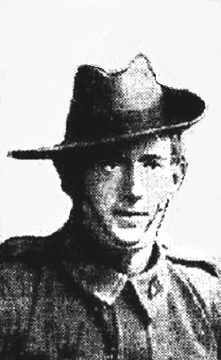ROBEY, George Horace Townsend
| Service Number: | 530 |
|---|---|
| Enlisted: | 18 August 1914, E Company |
| Last Rank: | Sergeant |
| Last Unit: | 9th Infantry Battalion |
| Born: | Manly, New South Wales, Australia, 14 July 1884 |
| Home Town: | Not yet discovered |
| Schooling: | Not yet discovered |
| Occupation: | Engineer |
| Died: | Illness, Manly, New South Wales, Australia, 29 February 1940, aged 55 years |
| Cemetery: | Not yet discovered |
| Memorials: |
World War 1 Service
| 18 Aug 1914: | Enlisted AIF WW1, Private, 530, 9th Infantry Battalion, E Company | |
|---|---|---|
| 24 Sep 1914: | Involvement Private, 530, 9th Infantry Battalion, --- :embarkation_roll: roll_number: '9' embarkation_place: Brisbane embarkation_ship: HMAT Omrah embarkation_ship_number: A5 public_note: '' | |
| 24 Sep 1914: | Embarked Private, 530, 9th Infantry Battalion, HMAT Omrah, Brisbane | |
| 24 Mar 1919: | Discharged AIF WW1, Sergeant, 530, 9th Infantry Battalion |
Help us honour George Horace Townsend Robey's service by contributing information, stories, and images so that they can be preserved for future generations.
Add my storyBiography contributed by Zidane McNamara
Summarizied from GWF
George Horace Townsend Robey was born on July 14th, 1884 in Manly, New South Wales to Horace Townsend and Violet Florence Robey [nee Townsend]. He was one of five children they would have, and he was the second oldest. He was baptized on August 16th, 1884 in Sydney. In the pre-war period, he was an Engineer and a prominent member of both the Lifesaving Club and Sailing Club in Manly. On August 18th, 1914 he enlisted into the A.I.F at Maryborough, Queensland, and he states he served 2 years in "No.1 Electrical Co. A.E". He embarked with his Battalion at Brisbane on September 24th, 1914. He was assigned to 'C' Company in Egypt. He wrote of the landings in a newspaper..
'The Turks opened a murderous fire on us. We were 200 yards from the beach, when the boats began to fill up because of the holes made by the bullets. Naturally they hit the bottom a long way from shore, and we had to tumble out up to our necks. We were being bowled over all the time. The noise and confusion were indescribable. Our orders were, 'Not a shot is to be fired.' When about 60 of us got together we charged up a hill. Sir Ian Hamilton, referring to it afterwards, said: "The famous historical charge at Balaclava cannot be compared with it. On that occasion they charged down a hill and were beaten. Here you charged up a hill and won." But our poor battalion is smashed to pieces.'
'It is 10 days since we landed, and it seems 10 years. The navy is still bombarding. The row is simply deafening, as the shells are bursting over our heads all the time. I was sent to the ship for a couple of days spell, and I can tell you it did not come before its time. After all the narrow escapes and experiences I have been through I feel quite dazed.'
'We only have seven officers left, and most of our N.C.O.'s are gone. I was set to work building a sandbag shelter for the wounded. They were actually being shot again and again while lying in the stretchers. There was nowhere to put them out of the range of the fire.'
'How I escaped being riddled with bullets I will never be able to understand. They went through my clothes, smashed my rifle, tore my haversack to pieces and only this morning I found a case of cartridges in my bandolier just over my heart smashed up'
'Of course I got some small cuts. One bullet gave me a nasty cut in the leg, and a piece of shrapnel struck my arm, but none of the wounds are serious. During the last 10 days I have seen men dropping all around me, and there has been nothing but an endless string of stretchers from the firing line to the beach.'
During the landing, he was recommended for the Distinguished Conduct Medal...
"[On April 25th,]Robey swam back to one of the boats under heavy fire and carried into safety a wounded comrade who was left in the boat, otherwise empty"
He was evacuated from Gallipoli sick but arrived back on the peninsula a week later. He was then with the Australian Records Section for 1916-17 before rejoining the 9th Battalion in August 1917. He finished the war as a Sergeant. He married and in 1934 would later form the Australian Air League which is still active today. George died of an illness in 1940.










